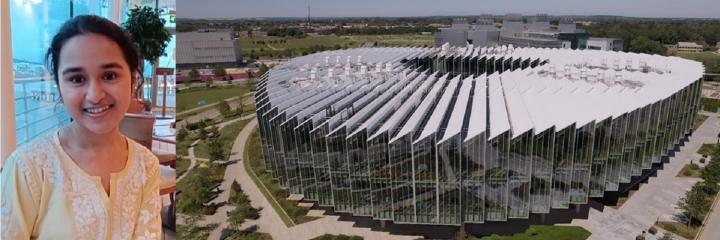Blog post by Student Rep Aditi Jain
Student Rep and Pharmacology student Aditi Jain blogs about her tour of the AstraZeneca Discovery Centre in Cambridge.

Women in Pharma
In August, 2022, International Society for Pharmaceutical Engineering (ISPE), in collaboration with MACE Group Ltd., organized a site tour of AstraZeneca’s new R&D facility, Discovery Centre (DISC) in Cambridge, especially for Women in Pharma. Our group included 8 women working in the life sciences sector including myself, a 3rd BSc (Hons) Pharmacology student from University of Edinburgh currently interning at Wockhardt UK .
International acclaim
Cambridge is an internationally acclaimed centre for research in the field of Biomedical Sciences. It hosts a number of globally renowned research institutes as well as biotech and medical technology companies – with AstraZeneca being one of the notable ones. Their new R&D facility, Discovery Centre (DISC) located in Cambridge is a mammoth 4 storeyed facility boasts of a multitude of labs with State of Art Technology with a total capacity of 2000 researchers and scientists to come together on a common platform.
I am currently interning at Wockhardt UK and my areas of work covers mainly R&D, Quality Assurance and Operational Excellence. My work currently does not allow me insights into the Engineering side of a pharmaceutical company. Visit to the DISC was an eye–opener for me with respect to behind the scenes of a large pharmaceutical cos. It provided me with an opportunity to understand Process Engineering and its importance in relation to the research that is carried out.
A tour of the plant room at the Discovery Centre gave me first-hand experience of the Waste Disposal System and its importance in a large R&D facility, RO Water Supply System, Liquid Nitrogen Supply System, and many more.
Out of all the systems and equipment, it was the Cell Banking Room that caught my attention. AstraZeneca has devoted an entire room filled with 40 Cryogenic freezers and a specialist team, purely for Cell Banking. It is just a foreboding of the kind of research AstraZeneca is planning to do in the near future. Visit to the facility explained clearly to me importance of an efficient and world class plant room, without which the centre would not be able to function. A world class R&D facility requires a World Class plant room.
Revolutionary architecture
What is most striking about the Discovery Centre is the use of glass outside and inside this campus. As a student, it made me very comfortable as I could observe all the work that was taking place in the facility. Further, I believe that the transparency that AstraZeneca is bringing to their work by adding glass facades to the facility is truly revolutionary. It is an exceptional way of building public’s confidence in the industry beyond the company and its products.
Moreover, the construction of this facility revolves around the concept of collaboration. The building holds an enormous open courtyard and a number of spacious meeting rooms which are accessible to everyone. It has purposefully been designed to be open so as to encourage interaction between their scientists and individuals from the surrounding scientific and medical community. They have proven the importance of collaboration in this project via their choice of location, too.
The DISC is situated at the heart of the Cambridge Biomedical Campus, which is undoubtedly one of the most exciting life science clusters in the world. Being neighbours with the Stem Cell Institute, Cambridge Institute, Miner Institute, Laboratory of Molecular Biology and many more such institutions, would aid in initiating new and more advanced research as well as strengthen the existing 200 collaborations. Increasing emphasis on collaboration by not just companies but also academic centres will be a significant move as it plays a crucial role in transformative innovation in contemporary drug discovery and development.
Having learnt the importance of transparency and collaboration in relation to the industry, I believe these attributes, if mimicked by professionals, would prove to be lucrative for their career too. As it would enhance their work quality, increase their efficiency and boost peer confidence in their work.
Another standout point of DISC is that it has been built to the highest environmental standards and will be an operationally carbon neutral building. The labs have Variable Air Volume (VAV) fume cupboards and the facility, altogether, has a low energy ventilation system, combined heat and power plant. It optimises natural light via solar controlled blinds and lighting control as well as possesses a rainwater harvesting system.
I found it quite remarkable how, despite the size of the project, AstraZeneca has ensured that environmental stability and energy efficiency are at the core of the building design and functionality.
An enriching experience
Insights gained into one of the finest R&D facilities in the UK coupled with an opportunity to understand the thought - process, values and goals of one of best pharmaceutical companies in the world, has been an enriching experience and the knowledge gained is exceptionally valuable because of the ability to see best-practises for ourselves, as well as network with peers. Thank you to the organisers, my placement managers and my mentor for the opportunity to take part in this special visit.

